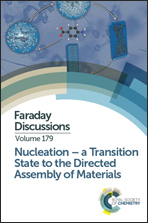Urea homogeneous nucleation mechanism is solvent dependent
Abstract
The composition of the mother phase plays a primary role in crystallization processes, affecting both crystal nucleation and growth. In this work, the influence of solvents on urea nucleation has been investigated by means of enhanced sampling molecular dynamics simulations. We find that, depending on the solvent, the nucleation process can either follow a single-step or a two-step mechanism. While in methanol and ethanol a single-step nucleation process is favored, in acetonitrile a two-step process emerges as the most likely nucleation pathway. We also find that solvents have a minor impact on polymorphic transitions in the early stages of urea nucleation. The impact of finite size effects on the free energy surfaces is systematically considered and discussed in relation to the simulation setup.
- This article is part of the themed collection: Nucleation – a Transition State to the Directed Assembly of Materials

 Please wait while we load your content...
Please wait while we load your content...